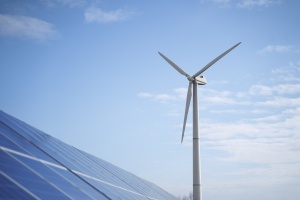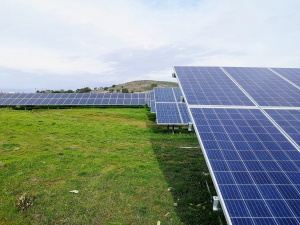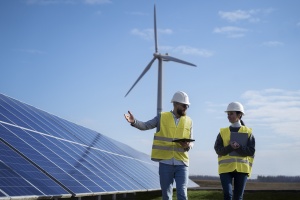The case for self-sufficiency in Vietnam’s energy mix
Vietnam’s recurring power shortages, spurred by heatwaves reducing water volumes at hydropower dams and increased demand for cooling, have highlighted the urgency for a clean energy transition and electricity conservation.
 |
| Niranpal Singh - Managing director BayWa r.e. Energy Solutions Asia-Pacific (left) and Bryse Gaboury - General manager BayWa r.e. Energy Solutions Asia |
The government issued a directive to urge people to conserve electricity on June 8 and further warned that the power situation will remain challenging for a long time as demand increases due to consumption.
For Vietnam, the ideal conditions needed to ensure sufficient electricity generation at the hydropower plants for the country’s needs will be impacted in the coming years due to climate change, which is a significant risk for the country.
What worsens it for Vietnam is that renewable energy supply from wind, solar and other sources is still limited.
In a recent report in ASEAN Business Times, it was revealed that at the end of 2022, wind and solar energy accounted for around a quarter of Vietnam’s total energy capacity, but the amount of electricity generated from these sources was only 12.9 per cent of the total power output, according to state-owned utility Vietnam Electricity.
Why is this so? It is because the owners of completed wind and solar projects are still locked in negotiations to connect their plants to the national electricity grid and are being hampered. Power cuts can seriously disrupt industrial activities.
Given the current issues faced, business continuity necessitates a move towards self-sufficiency models, especially for multinational corporations.
Major companies are urged to consider a reduced reliance on the grid and optimise energy usage, while minimising environmental impacts.
On-site solar generation, backed by advanced photovoltaic technologies and battery storage, offers a viable solution. This approach not only safeguards against power outages, but reduces energy costs and environmental impacts.
With Vietnam committed to transitioning towards clean energy, self-consumption energy models can shape the nation’s energy landscape.
Capitalising on the government’s green commitment, companies can take control of their energy needs through these models, serving as a temporary solution until a cleaner future is realised.
Given the current backdrop of power shortages, the announcement of the Vietnamese government’s Power Development Plan VIII is a shot in the arm for the country’s energy transition.
The plan calls for the expansion of renewable energy generation and the development of liquefied natural gas facilities to aid a gradual phase-out of coal-fired power plants.
The plan will require $134.7 billion in domestic and foreign investment by 2030 and will lay a pathway for Vietnam to achieve carbon neutrality by 2050 as part of Vietnam’s electricity development plan for this decade.
It calls for significant expansion of the country’s electricity grid, more than doubling its capacity from 69GW in 2020 to 150GW by 2030 to ensure national energy security and a burst of economic growth.
According to the plan, the government estimates it needs $134.7 billion of funding for new power plants and grids. By 2030, the hope is that wind, solar and other renewable sources (except hydropower) can cover 47 per cent of Vietnam’s energy needs, an increase from 30.9 per cent currently, with hydropower accounting for 19.5 per cent of the energy mix by 2030, down from 29 per cent in 2022.
The government has also committed to building new power transmission lines by 2030 to fully use the capacity of the country’s power plants, with the grid being linked with other countries in the region to enhance electricity change.
Vietnam also plans to have half the country’s office buildings and residential houses use rooftop solar power by 2030.
There are ways in which the government can further provide the impetus for companies to get on the clean energy transition. Apart from offering subsidies, accreditation and providing green certification as a means of acknowledging their efforts will also encourage the acceleration of the transition.
Such accreditation will also help in how companies report their sustainability path, which will also help them acutely, especially if they are exporting their products to the continental markets.
The government can really help by ensuring that the bureaucratic bottlenecks are cleared so that companies keen to start on their clean energy journey, can make the change, and swiftly too.
 | Vietnam's energy sector sparks interest from Chinese corporations The energy sector in Vietnam has piqued the interest of Chinese corporations, paving the way for collaborations and potential investments in renewable energy projects. |
 | Vietnamese province advocates for renewable energy law Representatives from Gia Lai province emphasised the urgency of enacting a dedicated Renewable Energy Law to overcome regulatory challenges and promote sustainable growth in the country's renewable energy sector. |
 | Vietnam's 15 renewable energy transition projects generate 154 million kWh In a significant stride towards renewable energy adoption, 15 transitional renewable energy projects have contributed approximately 154 million kilowatt-hours (kWh) of electricity. |
 | Vietnam's tough journey to reduce urban emissions In addition to adequate energy supply, the demand for smart energy in urban areas is viewed as a qualitative change in energy mobility in Vietnam. VIR’s Angela Nguyen talked with Mikael Jakobsson, executive director of the Asia Pacific Urban Energy Association on the issue. |
What the stars mean:
★ Poor ★ ★ Promising ★★★ Good ★★★★ Very good ★★★★★ Exceptional
Related Contents
Latest News
More News
- Heavy industries set for pilot greenhouse gas quotas (December 25, 2025 | 10:00)
- Swedfund invests in MSME growth and climate action in Vietnam (December 19, 2025 | 11:42)
- GreenYellow brings solar energy to light up remote schools in Tuyen Quang province (December 19, 2025 | 08:00)
- Charge+, Grab partner to develop EV charging network in Vietnam (December 18, 2025 | 17:11)
- Linking sci-tech and innovation to Vietnam’s net-zero future (December 18, 2025 | 14:31)
- Driving double-digit growth through green and circular transformation in Vietnam (December 17, 2025 | 09:00)
- Standard Chartered and ACCA deepen collaboration to develop Vietnam’s talent for a sustainable future (December 15, 2025 | 18:18)
- Schaeffler reports strong early output from Dong Nai solar project (December 12, 2025 | 15:16)
- Forestry conference highlights biodiversity and sustainability goals (December 09, 2025 | 13:35)
- Home Credit honoured among top 10 sustainable companies in trade and services (December 09, 2025 | 12:18)

 Tag:
Tag:



















 Mobile Version
Mobile Version